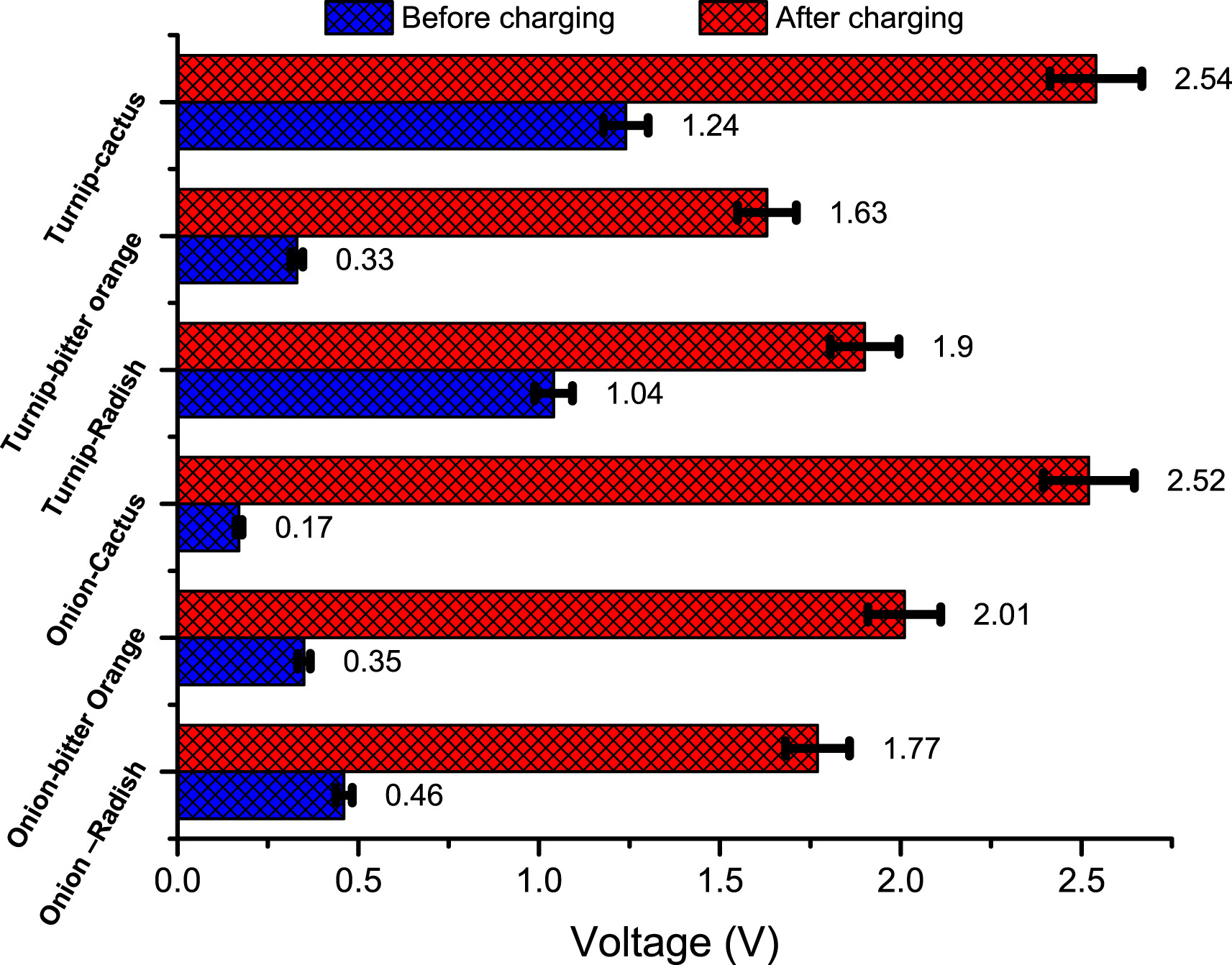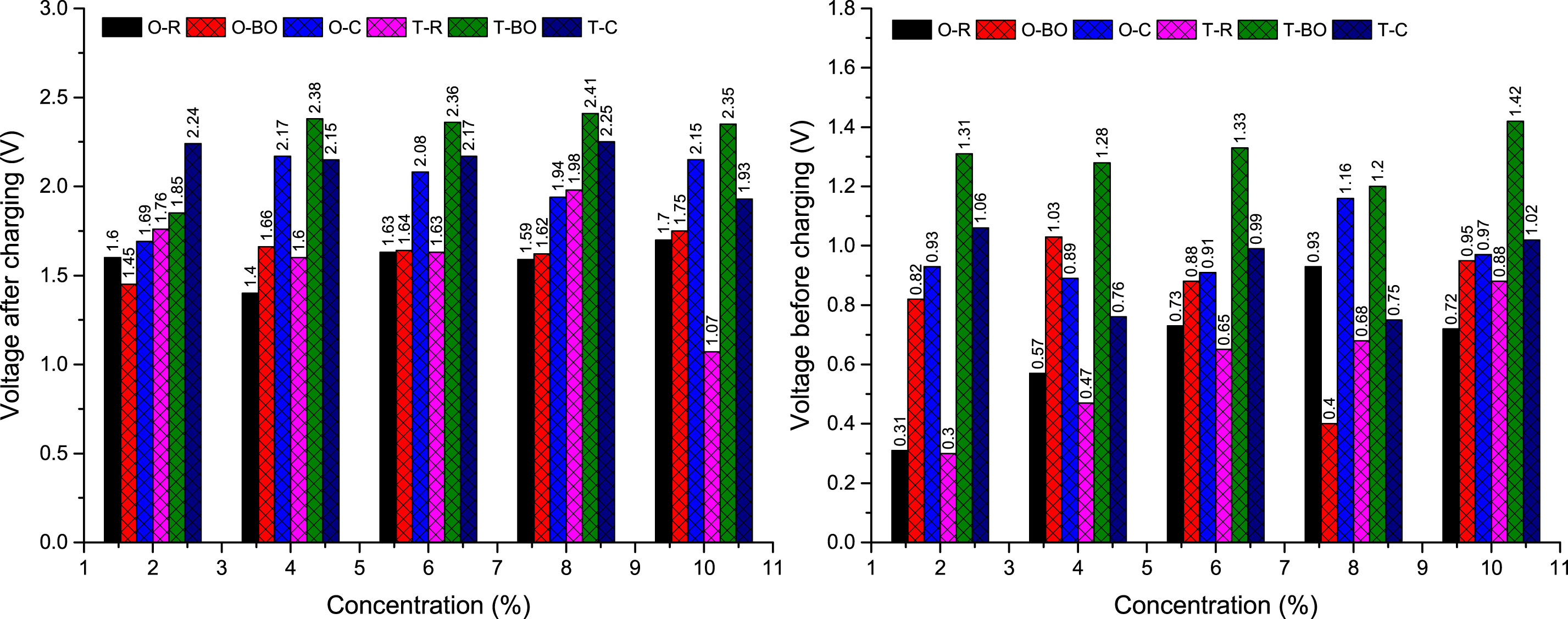Construction of rechargeable bio-battery cells from electroactive antioxidants extracted from wasted vegetables
Author: Shaharin Anwar Sulaiman - December 2021
Abstract
This work is focused on energy harvesting and energy storage through renewable sources. In many cases, vegetables may either get rotted or the market gets full due to imbalance in supply, price and demand. The waste vegetables and wild plants contain electrochemically active compounds, which can be used for preparation of rechargeable bio-battery cells. In this study, a set of battery cells was constructed by coupling the electroactive compounds of Onion-Radish, Onion-Bitter Orange, Onion-Cactus, Turnip-Radish, Turnip-bitter orange and Turnip-cactus. The fresh and boiled juices of these vegetables and wild plant combinations were used and the reaction conditions were optimized to maximize the output voltage. The output voltage was measured before and after charging of cells for different charging times, juice volume, charging voltage and pH of cell media. The effect of media was explored by changing the media nature from acidic to neutral and neutral to basic. It was observed that the voltage of most of the cells in basic media is higher than the neutral and basic media. Among the investigated batteries, turnip-cactus single cell battery produced an open circuit voltage of 2.13 V while the onion-radish battery produced an open circuit voltage 1.9 V.
Methodology
The bio-battery consisted of a single cell containing cathodic half and anodic half. Each half of the cell was filled with 50 ml of the freshly prepared juice. The batteries of onion series were prepared by using onion juice as anodic half cells while the other solution was filled into cathodic half. The anodic half for the turnip series was loaded with turnip juice. The container for bio-battery was made of high-density polyethylene. Each cell had two compartments for the formation of half cells. The salt bridge for these cells is made of a wick which is placed between cut between two compartments. This wick was a cotton cloth of 2 mm thickness, 1 cm width and 6 cm length. Each half cell compartment has a volume of 3.2 cm3. The graphite electrodes were mounted in a strip of cardboard and were connected to each other in series through copper connecting wires. The concentration of juice, charging time, boiling time, pH of solution, power of charger and nature of salt bridge was optimized using a single cell battery. However, the power of each battery was investigated using batteries consisted of five cells. The optimization experiments were conducted in triplicate and the average of these results was reported in this paper. The voltage was measured both before and after charging by using Fluke 115 multimeter. The constructed batteries were recharged using custom made and properly calibrated chargers. These chargers can be used for fast charging and their voltages can be adjusted to meet the needs of the cell.
Impact & Benefits
Environmental Sustainability: Utilizing wasted vegetables for the extraction of electroactive antioxidants reduces food waste, which is a major environmental issue. Instead of letting these vegetables decompose and emit greenhouse gases in landfills, their antioxidants are extracted for a useful purpose, promoting a more sustainable use of resources.
Renewable Energy: Bio-battery cells powered by electroactive antioxidants provide a renewable source of energy. As long as there is a supply of wasted vegetables, the antioxidants can be continuously extracted and used to generate electricity, making it a sustainable energy solution.
Cost-Effectiveness: Wasted vegetables are often considered a low-cost or even free resource, especially if they are obtained from food waste streams or surplus produce. By repurposing these otherwise discarded materials, the cost of producing bio-battery cells can be significantly reduced compared to traditional battery technologies.
Biodegradability: Unlike conventional batteries that often contain toxic materials and pose environmental risks when disposed of improperly, bio-battery cells made from natural antioxidants are biodegradable. This means that at the end of their lifecycle, they can be safely decomposed without causing harm to the environment.
Market Potential
Green Energy Market: With the growing global demand for clean and renewable energy sources, the market for green energy technologies, including bio-batteries, is expanding rapidly. Bio-battery cells offer a sustainable alternative to conventional batteries, particularly in applications where biodegradability and environmental impact are concerns.
Waste Management Industry: The extraction of electroactive antioxidants from wasted vegetables contributes to the circular economy by repurposing food waste streams. This aligns with the increasing emphasis on sustainable waste management practices, creating opportunities for companies involved in waste collection, processing, and recycling.
Battery Technology Sector: The battery technology sector is experiencing substantial growth driven by the rising demand for energy storage solutions in various industries, including automotive, consumer electronics, and renewable energy systems. Rechargeable bio-battery cells represent a niche within this sector, offering unique advantages such as biodegradability and low environmental impact.
Food Industry Collaboration: Collaboration between the bio-battery industry and the food industry can create synergies and new business opportunities. Food producers, processors, and retailers may see value in partnering with bio-battery manufacturers to repurpose food waste and demonstrate corporate social responsibility.


